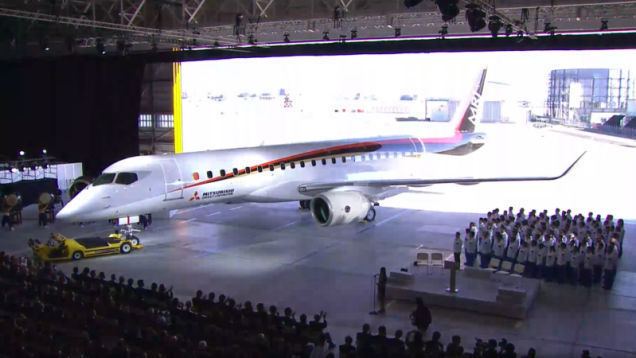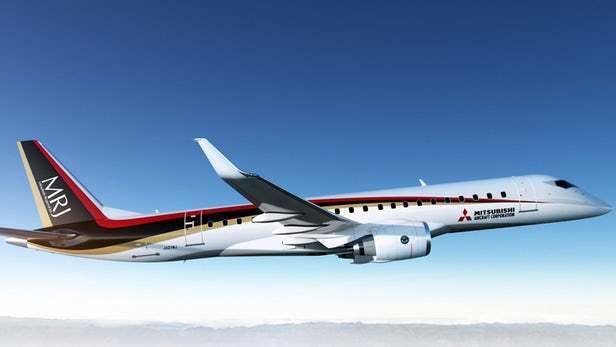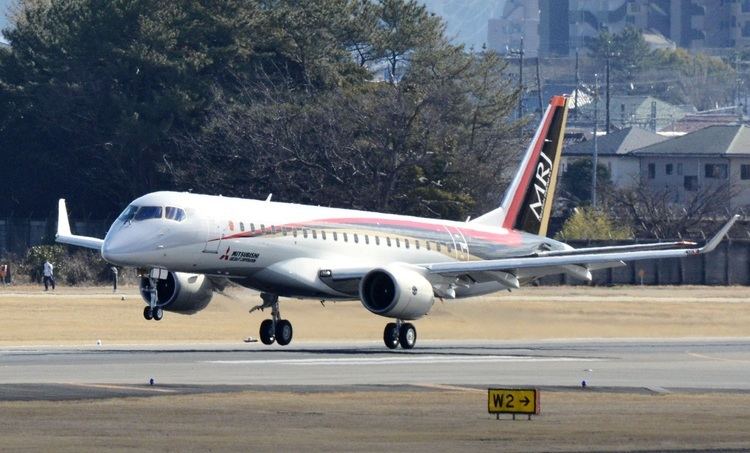Wingspan 29 m | First flight November 11, 2015 | |
 | ||
Manufacturer Mitsubishi Heavy Industries, Ltd. | ||
The Mitsubishi Regional Jet (Japanese: 三菱リージョナルジェット), or MRJ for short, is a twin-engine regional jet aircraft seating 70–90 passengers manufactured by Mitsubishi Aircraft Corporation, a partnership between majority owner Mitsubishi Heavy Industries and Toyota Motor Corporation with design assistance from Toyota affiliate Fuji Heavy Industries, already a manufacturer of aircraft. It will be the first airliner designed and produced in Japan since the NAMC YS-11 of the 1960s, which was produced at a loss. Its first flight was in November 2015. After a fifth delay, deliveries are scheduled to start by mid-2020.
Contents
- The first japanese made passenger jet mitsubishi regional jet mrj90
- History
- Construction
- Production
- Flight Testing
- Stretch
- Specifications
- Orders
- Potential orders
- References

The first japanese made passenger jet mitsubishi regional jet mrj90
History

In 2003 the Japanese government started a five-year, ¥50 billion ($420 million) research program to study an indigenous regional jet for 30 to 90 passengers, led by Mitsubishi Heavy Industries (MHI). In 2004 MHI was focused on a 2m high by 2.8m-wide, four-seat abreast cabin, seating 30 to 50 passengers, and was hoping to fly a prototype in 2007 and deliver the first aircraft in 2010. In 2005 it switched to a larger 70-90 seat category.

MHI launched its concept at the 47th Paris Air Show in June 2007, showing a full-scale cabin mock-up and aiming to be the first regional jet all-composite airframe, with certification targeted for 2012. Mitsubishi formally offered the MRJ to airlines in October 2007 - the first Japanese airliner since the NAMC YS-11 production stopped in 1974 - after being the first airframer to select the Pratt & Whitney PW1000G geared turbofan offering a 12% reduction in thrust specific fuel consumption, rated at 15,000 lbf (67 kN) thrust on the 70- to 80-seat MRJ70 and 17,000lb thrust (75.7kN) on the 86- to 96-seat MRJ90, projecting a ¥150 billion ($1275 million) development cost.

MHI officially launched the Mitsubishi Regional Jet Program on March 28, 2008 with an order for 25 aircraft (15 firm, 10 optional) from All Nippon Airways, targeting a 2013 introduction. Mitsubishi is targeting a 20% share of 5,000 sales forecast in the 70-90-seat bracket over 20 years but Teal Group's Richard Aboulafia believes its launch is political, its weight per passenger doesn't seem very low, and its main competition, the Bombardier CRJ700 series and Embraer E-Jet can be re-engined with the Pratt & Whitney PW1000G.
Construction

In September 2009 Mitsubishi unveiled extensive design changes, using aluminium instead of carbon fibre composites for the aircraft's wings and wingbox; the remaining composite parts will make up 10-15% of the airframe: the empennage, horizontal tail and vertical tail. The cabin height is increased by 1.5 in (4 cm) to 80.5 in (204 cm) and the fuselage height is increased to 116.5 in (296 cm), giving a rounder cabin, wider and higher than its competition. The program is delayed six months with final design frozen in mid-2010, first flight is delayed to the second quarter of 2012 and deliveries should begin in early 2014.

MHI employs new production methods such as integral wing stringers, unusually tight tolerances, shot peening of curved surfaces, and vacuum assisted resin transfer molding, intended to increase quality and thus reduce expensive fault correction to keep price competitive.
Production

On 15 September 2010, the Mitsubishi Aircraft Corporation announced that it had entered the production drawing phase and was proceeding with the manufacturing process. Assembly of the first aircraft began in April 2011 with construction of the emergency escape for the cockpit.

A new production facility for the aircraft will be built at Komaki Airport in Nagoya, Japan, on land purchased from the government at a total cost of 60 billion yen. Production at this plant is expected to commence in fiscal year 2016, with the new plant producing 10 aircraft per month and employing 2,000 workers. Mitsubishi announced in June 2013 that it would establish a quality control facility in Illinois for the sourcing of MRJ components from the United States.
Flight Testing
The first flight, scheduled after the design was finalized, was to take place in the second quarter of 2012, but was delayed to 2013, and then further delayed to spring 2014 due to delays in the procurement of engines. Likewise the first delivery was planned to take place in the first quarter of 2014, but was delayed to mid to late 2016. In August 2013, Mitsubishi announced a third major delay to the program, and that the first flight would take place by summer 2015 while the first delivery would take place by summer 2017. Delays in the procurement of the Pratt & Whitney engines and other components were cited as the cause of this delay.
In September 2013, after announcing the third delay to the MRJ program, Mitsubishi publicly displayed a prototype MRJ fuselage, including cockpit enclosure, and announced that it would hire foreign pilots and technicians to serve as consultants as the program progressed to safety testing and regulatory approvals. Pictures of the first fully assembled MRJ90 were available on 26 June 2014, and an official rollout occurred on 18 October 2014.
The maiden flight of the MRJ90 took place on 11 November 2015. On 24 December 2015, Mitsubishi announced a one-year delay for the first delivery of the MRJ, to mid-2018. The delay was attributed to insufficient wing strength and the redesign of the landing gear for better safety.
Static strength test were completed on November 1, 2016 and confirmed that the airframe could withstand 1.5 times the maximum load.
Stretch
A 100-seat stretched MRJ100 was studied in March 2011. As of June 2015 it was still under evaluation.
Specifications
Two different fuselage lengths are planned using three weight variants each :
Orders
All Nippon Airways was the first customer, with an order for 15 MRJ 90s and an option for 10 more.
In March 2008, and again in October 2008, Sankei Shimbun and Fuji Sankei Business I reported that the government of Japan would buy ten MRJs to serve as short-haul and small-field VIP transports, supplementing the existing Japanese Air Force One Boeing 747 aircraft. The government was still considering this option as of July 2013, with MRJs possibly supplementing new Boeing 777 long-haul VIP transports, according to the Nihon Keizai Shimbun.
In 2008, Mitsubishi estimated that 300-400 MRJs would be necessary to recover the $1.9-billion programme cost.
At the July 2012 Farnborough Airshow, SkyWest agreed to buy 100 MRJ90s, to be delivered between 2017 and 2020. The deal is worth $4.2bn at list prices. During the 2013 Regional Airlines Association conference, held in Montreal, Canada, Mitsubishi announced that ANI Group Holdings, which firmed a MoU for 5 MRJ aircraft in June 2011, cancelled the deal, without giving further details.
Potential orders
In 20 July 2016, one of the officials at Iran's ministry of transportation announced Iran is buying 25 ATR airplanes for Iran Aseman Airlines and for further purchases Mitsubishi has showed interest in offering 20 MRJ planes.
